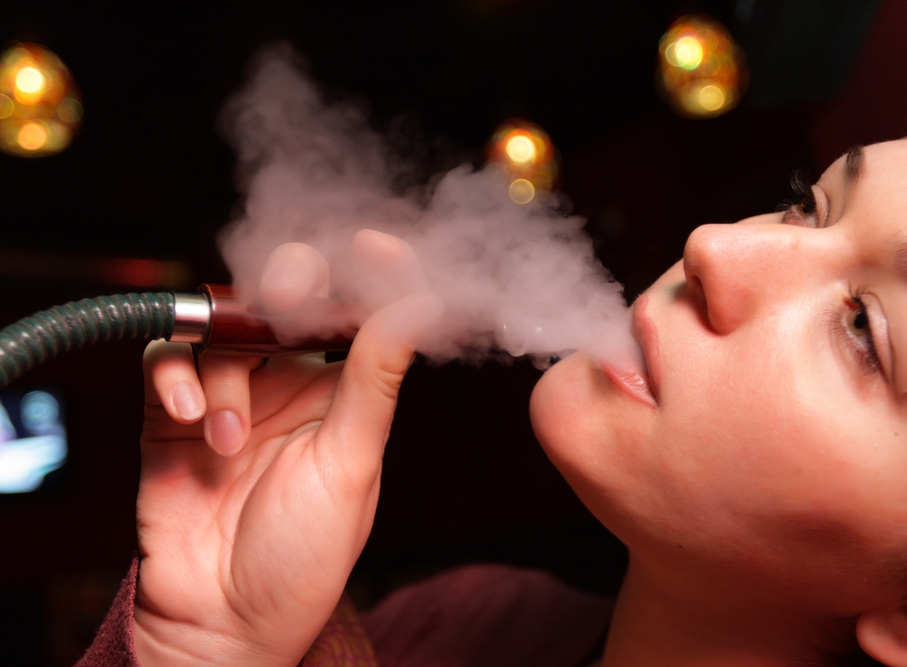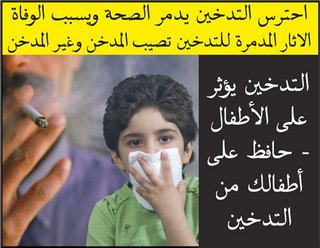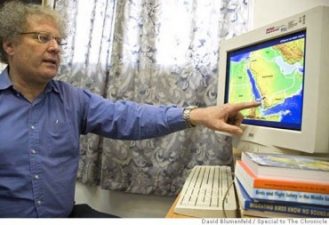
If new anti-smoking images slapped on Jordan’s smokes don’t help puffers kick the habit, maybe Jordan should look Down Under for greater motivation: Beginning this year, as part of Jordan’s obligations to the World Health Organization’s Framework Convention on Tobacco Control (FCTC), the Ministry of Health asked cigarette companies to feature graphic anti-smoking images on cigarette packs. These images are too graphic for us to post. Google will ban our ads here if we do.
 So packs sold in Kingdom now contain very small pictures of a damaged lung, or a coughing child (see image at left), or a cartoony-fetus in its mama’s womb.
So packs sold in Kingdom now contain very small pictures of a damaged lung, or a coughing child (see image at left), or a cartoony-fetus in its mama’s womb.
The change aims to sharply raise awareness of tobacco-caused diseases and the dangers of second-hand smoke.
According to smokers interviewed by The Jordan Times, it’s not working.
Musa, who’s smoked for 16 years, told the paper, “Whatever they are going to place on the tobacco packs, I will not quit smoking, unless I want to.” George, another interviewee, said, “These pictorials have no effect. I open the pack and smoke without paying any attention to the images.”
Cigarettes sold in duty-free shops or on the black market don’t bear the no-smoking imagery.
A study conducted by the King Hussein Cancer Center’s cancer control office had indicated that the graphics would motivate an estimated 25% percent of smokers to quit.
“I don’t care what pictures they put on the cigarette packet,” Mohammed told the Times. “I started smoking when I was 18, and I haven’t stopped since. I don’t think a picture would make me stop smoking.”
Female smokers said they weren’t put off by the photos. Raeda noted that kicking the habit was a personal choice, saying, “Nothing, neither placing ugly images nor increasing cigarette prices would encourage me to quit smoking unless I want to.”So she says, but steeply raising cigarette prices with hefty taxation does prompt even long-term users to kick the habit.
Last year the Department of Statistics reported that Jordan’s cigarette spending was on the rise, with total spending on tobacco products reaching $678.7 million in 2010 (compared with $497.4 million in 2008). The Heath Ministry reports that smoking cost the country $1.4 billion last year, including money spent on money spent smoke-related diseases.
Smoking similarly smacked the Australian economy, with annual health costs at $33 billion and an estimated death toll of 900,000 over the last 60 years. So in 2012, Australia took it up a notch: the High Court ruled that all smokes must be sold in uniform packaging with minimal branding or logos on a drab brown background. The packs feature a range of eye-popping (and stomach-turning) imagery of a gangrenous foot, a cancerous mouth, or a cadaverous cancer sufferer; in-your-face reminders of the risks of lighting up. See image above for an example.
“They’re so horrifyingly ugly that they are magnificent,” Fiona Sharkie, executive director of anti-smoking campaigner Quit Victoria told Bloomberg News. She said callers to its hotline said the packaging was the “final push” they needed to stop smoking.
Approximately 29% of Jordanians above 18 are smokers, in addition to 14% of kids between ages 13-15, one quarter of whom smoke sheesha. According to WHO, tobacco is killing about 6 million people each year. It contains over 4,000 chemicals of which 60 are carcinogens, in addition to addictive nicotine.
Scary statistics warrant scary warnings. Jordan would be wise to adopt the new Australian packaging and pull no punches when it comes to tobacco addiction.



